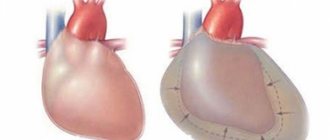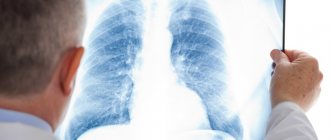Facial swelling is not only a cosmetic defect; if it appears frequently or is accompanied by redness and pain, it is a sign of quite serious health problems that need to be identified and treated.
ALENA PARETSKAYA
Pathophysiologist, immunologist, member of the St. Petersburg Society of Pathophysiologists ANDREY GRACHEV Leading cardiologist of the SM-Clinic holding, MD, academician of the Russian Academy of Medical Sciences
Facial edema is not a separate disease, but only a reflection of an imbalance between retention and excretion of fluid in the body. But what problems in the body can cause the face to swell and how serious is it?
Why does the face swell in adults?
Swelling on the face can occur at different times of the day - mainly in the morning or late afternoon, or they persist throughout the day, decreasing or increasing.
There are two types of reasons:
- physiological (or natural, not associated with diseases), they are usually not pronounced, not very strong, and disappear quickly;
- pathological, can be very strong, with changes in facial features, signs of inflammation, and are often quite persistent.
Each type of edema has the most typical causes; they occur mainly in the morning or evening hours, or do not depend in any way on the time of day. These characteristics are important for the doctor so that he can identify the leading causes and determine the tactics of examination and treatment.
Blepharitis Treatment Methods
Treatment of blepharitis requires an integrated approach, involving both local and general therapeutic measures.
The cause that caused the blepharitis must be eliminated, otherwise local treatment risks not being effective and resumption of inflammation is very likely. The complex of general treatment measures includes:
- vitamin therapy;
- therapeutic nutrition with a high protein content and the exclusion of possible allergens;
- general strengthening and immunostimulating techniques;
- elimination of foci of infection existing in the body (treatment of concomitant diseases.
It is necessary to ensure proper eye hygiene. If necessary, vision correction should be performed to relieve tension in the eye muscles.
Specialist consultation
Local drug treatment is prescribed by a doctor; the specifics of treatment depend on the form (type) of the disease.
For treatment of blepharitis, you should consult an ophthalmologist.
Make an appointment Do not self-medicate. Contact our specialists who will correctly diagnose and prescribe treatment.
Rate how useful the material was
thank you for rating
Is there swelling on the face due to heart disease?
Yes, these questions usually worry women, says cardiologist Andrei Grachev.
They run to see a cardiologist when they can’t put a ring on their finger in the morning because it’s swollen or put on makeup because their face is swollen. The patient wants to look great, regardless of age and health status. And this is commendable. Men, as a rule, do not contact a cardiologist with such questions. The peculiarity of this issue is due to the fact that in patients with cardiovascular diseases, as a rule, swelling on the face appears at the final stage of a complication such as heart failure. First, they appear on the legs (the lowest point in relation to the heart), then fluid accumulates in the abdominal cavity, the liver and spleen enlarge (as a blood depot). And only after the fluid reaches the pleural cavities and the heart sac, swelling may occur on the face or hands.
Types of blepharitis
Simple blepharitis
If the edge of the eyelid just turns red, they talk about simple blepharitis
.
Squamous blepharitis
With scaly blepharitis, dry grayish-yellow scales, reminiscent of dandruff, form at the roots of the eyelashes. If the scales are removed, thin, reddened skin can be found underneath.
Ulcerative blepharitis
Ulcerative blepharitis usually develops as a result of staphylococcal infection. With ulcerative blepharitis, pus accumulates in the hair follicles of the eyelashes. Eyelashes stick together. At the base of each such tuft of eyelashes there is a yellow purulent crust, and if it is removed (the eyelashes usually fall out), an ulcer opens in its place. In place of healed ulcers, scar tissue forms, which can prevent normal eyelash growth. In severe cases, the entire eyelid margin may be distorted. Madarosis is also possible
– complete loss of eyelashes.
Meibomian blepharitis
In meibomian blepharitis, the meibomian glands become inflamed. Inflammation is caused by increased production of secretions that accumulate at the mouth of the gland. There is a blockage of the mouth, which manifests itself as the appearance of transparent bubbles along the edge of the eyelid.
When do they occur most often?
Due to a number of circumstances, adds cardiologist Andrei Grachev, such as the flow of fluid to the upper half of the body in a lying position, changes in the biorhythms of hormone production (more often their active synthesis occurs at night or in the early morning hours), edema syndrome most often manifests itself in the early morning hours .
Morning
If we talk about physiological reasons, morning swelling is usually associated with constant lack of sleep, fasting or strict diets (limiting protein and fats). Sometimes swelling in the morning is caused by the wrong selection of skincare products (face cream, toner or cleanser). Also, morning swelling of the face can be caused by crying or stress in the evening or at night.
Possible swelling of the face in the morning due to an incorrectly selected pillow (it is too high, it provokes a narrowing of the blood vessels in the neck). Another physiological factor is an excess of fried, salty foods or liquids taken in the evening, before bed. In women, facial swelling in the morning can be caused by hormonal fluctuations, PMS or pregnancy. Some women report morning swelling during menopause.
Pathological causes of morning edema are mainly kidney damage. Such swelling is usually soft, mobile, appears on the face after sleep, and the skin acquires a waxy or yellowish tint. The most common causes of facial swelling are:
- glomerulonephritis - the acute form of the disease leads to edema, which lasts up to 2-3 weeks, if the process enters the chronic phase, edema is typical for periods of exacerbation of inflammation;
- Kidney amyloidosis - edema is typical of the second stage (proteinuria), when protein loss occurs and kidney function gradually deteriorates;
- membranous nephropathies - occur after taking certain medications, tumor therapy, acute infectious pathologies. Edema occurs in waves, with sharp or barely noticeable symptoms;
- chronic kidney disease (previously called renal failure) - swelling occurs gradually as renal damage progresses;
- kidney damage in severe systemic pathologies - edema is typical for nephropathy due to diabetes or systemic lupus erythematosus.
Evening
Sometimes facial swelling becomes noticeable in the evening, especially after an active day. Often this is one of the manifestations of pathologies of the cardiovascular system. Often, swelling of the face is accompanied by severe swelling in the area of the extremities - hands and feet, legs. These swellings are denser, the skin has a lower temperature than on other parts of the body, and such swelling goes away slowly. Often occur against the background of the following pathologies:
- amyloidosis of the heart and blood vessels;
- cardiomyopathy;
- sclerotic heart disease (cardiosclerosis);
- certain types of arrhythmia;
- constrictive pericarditis;
- some heart defects;
- arterial hypertension;
- cardiac lesions due to rheumatism.
Day
Sometimes facial swelling is most pronounced during the day or its appearance is not clearly related to the time of day. Among the main pathologies that lead to such edema are endocrine disorders - especially a lack of thyroid hormones (hypothyroidism). Facial swelling is especially pronounced with congenital hypothyroidism, in pregnant women or with autoimmune thyroiditis, cytokine-induced thyroiditis.
Rapidly increasing swelling of the face during the day can be a sign of allergies - to food, insect bites, cosmetics, medications and even cold. Sometimes facial swelling occurs during an attack of bronchial asthma due to difficulty breathing and fluid retention in the veins.
Facial swelling is possible in people who smoke and drink alcohol. This is due to the increased work of the lymphatic system to remove toxins from tissues.
Severe swelling of the face during the day is possible with respiratory infections and their complications - sinusitis, tonsillitis, frontal sinusitis. Swelling of the face is possible with a deficiency or excess of vitamins (especially fat-soluble ones).
Types of skin diseases around the eyes and eyelids
Among the huge number of diseases caused by inflammation of the eyelids, several of the most common groups can be distinguished:
- bacterial lesions of the skin of the eyelids (abscess of the eyelid, phlegmon);
- inflammatory diseases of the glands and edges of the eyelids (blepharitis, barley, chalazion, meibomitis, demodicosis);
- violations of the shape and position of the eyelids (entropion, eversion, ptosis, lagophthalmos);
- allergic diseases (eczema, dermatitis, angioedema);
- developmental abnormalities of the eyelids and tumors (coloboma, papilloma, lipoma, nevus).
Bacterial lesions of the skin of the eyelids
Abscess of the century
An abscess is inflammation and redness of the eyelid with the formation of a cavity filled with pus. Often an abscess appears after an infected eyelid wound.
Causes of eyelid abscess:
- ulcerative blepharitis;
- boils;
- barley;
- purulent processes in the paranasal sinuses and orbit of the eye.
Sometimes the abscess opens on its own, and the inflammation subsides. But in most cases, a non-healing fistula appears at the site of inflammation.
Treatment of an abscess is sanitation of the eyelids and opening of a purulent formation on the eyelids with the mandatory use of antibiotics and sulfonamides.
Phlegmon
Cellulitis is an extensive inflammation of the tissues of the eyelid that occurs against the background of untreated stye. It is characterized by fever, headache, severe swelling of the eyelid and redness of the skin.
Treated with antibacterial agents, antihistamines.
Inflammatory diseases of the glands and edges of the eyelids
Blepharitis
Blepharitis is an inflammation of the eyelids, which causes redness, burning, itching and pain on the skin.
The following types of blepharitis are distinguished: allergic, meibomian, demodectic, infectious, scaly. Read more about blepharitis here.
Barley
Barley is an acute, infectious inflammation of the eyelids, resulting from pathogens entering the eyelash hair follicle or the sebaceous gland of the eyelid. Visually, stye looks like a small nodule on the eyelid.
You can read about how to properly treat stye on this page.
Meibomyitis and chalazion
Meibomyitis and chalazion are diseases associated with the appearance of a pathological process in the meibomian glands.
Meibomia appears when the duct of the sebaceous gland of the eyelid is clogged. Characterized by an acute course of the disease.
Chalazion is a chronic form of meibomitis. If a chalazion is left untreated for a long time, it turns into an eyelid cyst. Sometimes, for diagnostic purposes, it is necessary to puncture the eyelid cyst to identify the nature of the neoplasm.
Treatment and removal of a cyst on the eyelid occurs using classical techniques or laser treatment.
For more information about the symptoms and treatment of this pathology, see here.
Demodicosis
A disease of the eyelids caused by the Demodex mite. It is characterized by the appearance of yellow mucus in the eyes, gluing and breaking of eyelashes, itching and burning of the eyes.
To cleanse the eye from foci of infection, cleaning (sanitation) and rinsing of the lacrimal ducts are used. Read about the treatment of demodicosis on this page.
1 Diseases of the skin around the eyes and eyelids. Diagnosis and treatment
2 Diseases of the skin around the eyes and eyelids. Diagnosis and treatment
3 Diseases of the skin around the eyes and eyelids. Diagnosis and treatment
Violations of the shape and position of the eyelids
Turn of the century
When the eyelid is inverted, its main edge is turned onto the eyeball. Because of this, the eyelashes touch the surface of the cornea and conjunctiva, the eyes become red, irritated, and tears constantly flow from them.
Causes of pathology:
- convulsive or spastic contractions of some parts of the orbicularis oculi muscle;
- cicatricial contractions of the conjunctiva and cartilage of the eyelid that occur in certain chronic eye diseases (for example, trachoma).
The most effective method of treatment is surgery. Plastic surgery for entropion of the eyelid is also possible.
Eversion of the century
Ectropion is an inversion of the edge of the eyelid. With this inflammation of the eyelid, the conjunctiva turns out in a certain area or throughout the entire eyelid, which leads to its drying out.
The fact that the eye is constantly open, even at night, contributes to clouding of the cornea, the appearance of keratitis and other diseases.
Causes of eversion of the eyelid:
- age-related changes in the eye with sagging of the lower eyelid;
- paralysis of the orbicularis oculi muscle;
- tightening of the skin of the eyelids due to injuries, burns (cicatricial eversion), systemic diseases of the body.
First, it is necessary to eliminate the main causes that caused this disease. Surgical procedures can then be used.
Ptosis
Ptosis is an abnormally low position of the upper eyelids in relation to the eyeballs. This leads to vision defects and rapid eye fatigue. Ptosis can be congenital or acquired.
Causes of ptosis:
- damage to the oculomotor nerve;
- damage to the muscle that elevates the upper eyelid;
- strokes, encephalitis and other neurological diseases.
Treatment of the disease is mainly surgical.
Lagophthalmos
Lagophthalmos is incomplete closure of the palpebral fissure, which leads to damage and drying of the cornea and conjunctiva.
Causes of the disease:
- eyelid injuries,
- jades,
- short eyelids from birth.
In addition to treating the underlying disease, artificial tears and disinfectant drops are prescribed. In severe forms of the disease, surgical intervention with partial suturing of the palpebral fissure is used.
Allergic inflammation of the eyelids
Allergic diseases of the eyelids are accompanied by severe itching, swelling and inflammation of the eyelids.
In eczema , the skin of the eyelids is covered with papules, vesicles and pustules. Characteristic rashes appear not only on the skin of the eyelids, but also on the body. The pathology develops after suffering eyelid dermatitis or contact with allergens. At the end of the disease, crusts and serous exudate appear on the skin of the eyelids.
Characteristic signs of urticaria are swelling of the eyelids, itching and burning of the skin of the eyelids. Subsequently, blisters appear on it.
With contact dermatitis , 6 hours after contact with the allergen, swelling and inflammation of the eyelids develop with itchy papules and vesicles. Usually both eyes are affected at once.
Treatment of allergic inflammation of the eyelids is medicinal.
1 Diseases of the skin around the eyes and eyelids. Diagnosis and treatment
2 Diseases of the skin around the eyes and eyelids. Diagnosis and treatment
3 Diseases of the skin around the eyes and eyelids. Diagnosis and treatment
Anomalies of eyelid development and tumors
Coloboma
Coloboma of the eye is one of the most unpleasant diseases, which is expressed in the absence of some eye membranes. Coloboma of the eyelid is the most common. The pathology appears on the upper eyelids, but sometimes affects the lower eyelids too.
Coloboma is usually triangular in shape, where the base of the triangle is the ciliary edge of the eyelids. Since the defect affects all layers of the organ of vision, there are no eyelashes and glands in the area of coloboma.
In most cases, it is congenital, but can also occur as a result of injury and other illnesses. Another type of congenital coloboma, iris coloboma, is one of the main causes of vision loss in childhood.
Coloboma is a serious danger to the eye, as it leads to degeneration of the cornea, keratitis and other secondary diseases of the organs of vision, as well as blindness!
The most effective treatment for coloboma is surgery. Surgery for coloboma involves excision of damaged tissue and movement of a musculocutaneous flap to the site of the defect. With the help of plastic surgery, the correct edge of the eyelids is formed, which prevents the appearance of ptosis, entropion, and other complications.
Benign formations of the century
Papilloma of the eyelids
Papilloma appears on the lower eyelid usually in people over 60 years of age.
It grows slowly, looks like gray-yellow papillae, and has a spherical or cylindrical shape. In 1 case out of 100, papilloma can turn into cancer. Treatment of eyelid papilloma is surgical.
Senile wart
A senile wart is a flat and even formation of brown, yellow or gray color. It grows in older people along the lower ciliary edge of the eyelids. Treatment: cryodestruction or laser removal.
Cutaneous horn
The cutaneous horn is a dirty gray formation protruding above the eyelid. Electro- and laser excision are used for treatment.
Nevi
Nevus (or mole ) is a benign formation on the skin, from light brown to black. Nevi on the eyelid can be inherited, appear due to long exposure to the sun, disruptions in the hormonal system, or after taking certain medications. Hanging moles can appear in old age. If the formation does not bother you, there is no need to treat it.
If unpleasant symptoms appear: itching, pain, growth, blurred vision, you must consult an ophthalmologist to investigate the nature of the mole and receive the necessary treatment.
Atheroma
Eyelid atheroma ( epidermal cyst ) is a painless, dense formation that appears on the eyelid due to blockage of the sebaceous gland ducts.
Over time, the atheroma begins to increase in size and can impair vision. In this case, surgical procedures are performed. After removal of atheroma of the eyelid, there are usually no complications.
How to quickly relieve facial swelling in adults
If this is physiological swelling of the face, not associated with serious pathologies that require medical supervision and the use of selected medications, excess fluid can be eliminated through certain simple measures and actions.
Taking a contrast shower or washing with cold/hot water. This method refreshes, increases tissue tone, enhances the outflow of fluid from the skin and reduces swelling.
Using ice – a couple of pieces of ice will help deal with swelling on the face quickly and effectively. In addition, you can prepare herbal decoctions with a tonic effect in advance and freeze them, using them for washing.
Facial massage is an effective remedy that helps improve microcirculation and swelling. Manual massage, the use of rollers, ice cubes, and cold spoons help. Sometimes you can first wipe your face with green tea and apply compresses with it to your face and eye area.
Swelling under the eyes not associated with diseases
- Hereditary factor.
- Fatigue, overwork and insomnia.
- Severe and prolonged eye strain (behind the TV and monitor screens)
- Excessive consumption of alcohol, drugs and smoking.
- Excessive salt intake.
- Cyclic hormonal changes in the female body.
- Injury to the area around the eye. This also includes a bruise, that is, swelling of the eye from a blow, which many people treat on their own.
Swollen eyes in a child, what to do
It is believed that swelling is an age-related problem, but often swelling under the eyes can be seen even in a child. As a rule, if this is not caused by one of the listed reasons, then swelling of the eyes in the morning after sleep in a child does not need treatment, since most likely it is due to non-compliance with the regime or drinking plenty of fluids at night.
How to quickly remove puffiness from eyes at home
If the swelling is caused by an infectious disease, treatment should be prescribed by a doctor - usually a course of antibiotics and anti-inflammatory drugs. Traditional medicine knows very well how to quickly relieve swelling around the eyes and remove marks caused by fatigue or a stormy party the night before. Compresses made from tea leaves, raw potatoes or parsley help well. Applying ice relieves swelling and reduces pain.
Professional treatment for swollen eyes
Ultraclinic specialists look at any cosmetic problem from different angles. What could cause eye swelling in your case - is it the result of a disease, lifestyle or heredity? After consultation, a course of therapy may be prescribed. We recommend not just mechanical removal of swelling, but restoration of the functions of the skin and internal organs. First of all, as with any swelling, you need to check whether it is caused by an illness or allergy.
At Ultraclinic you can take the necessary tests and receive a conclusion. The selection of professional cosmetics is an important component of the treatment of edema. The first answer to the question: why is there a lot of swelling under the eyes and what to do is usually a trip to a cosmetic store. However, the abundance of products for the skin around the eyes in stores cannot always solve the problem of puffiness. And if it is caused by an allergy, then it may intensify under their influence. Our experienced cosmetologists will select care products taking into account your characteristics.
Procedures for the treatment of eye swelling at the Ultraclinic
Skincare procedures. At your appointment, a cosmetologist will specifically select for you professional creams and masks that help reduce puffiness, and will tell you how to remove circles and puffiness under the eyes.
Causes of development of inflammatory eye diseases
Clinicians identify the main etiological factors of eye diseases
:
- contact of an infectious agent (virus, bacteria, fungi) on the surface of the conjunctiva with dirty hands, when swimming in contaminated bodies of water;
- hematogenous spread of pathogenic microorganisms from foci of chronic infection;
- prolonged exposure to ultraviolet radiation (including “snow blindness”);
- allergic reactions to medications, pollen;
- eye fatigue, constant work at the computer;
- injuries, ingress of foreign objects;
- irritating effects of smoke, atmospheric pollutants, chemical reagents.
Causes of eye disease
Less common causes of eye disease
: long-term wearing of contact lenses, metabolic disorders, vitamin A deficiency, endocrine diseases, atherosclerotic and other vascular lesions of the eyeball.
Diagnosis of corneal edema
The most informative diagnostic method for corneal edema is pachymetry
. This contact (ultrasound) or non-contact (slit lamp) examination method can measure the thickness of the cornea and provide information about its general condition.
Sometimes, to obtain more accurate data, pachymetry is combined with biomicroscopy. In our clinic, you will not only undergo the necessary diagnostics, make an accurate diagnosis, but also prescribe the most effective treatment, taking into account the individual characteristics of the body.
How to remove swelling of the eyelids?
To restore a healthy appearance to your eyelids, you can use the following techniques:
- Compresses with chilled green or chamomile tea bags or ice cubes. The ice can be ordinary, or for a more effective effect you can use frozen infusions of herbs: sage, lavender, chamomile, mint, St. John's wort. Place a bag or cube in gauze and apply to problem areas for 10–15 minutes.
- Or add chilled teaspoons. Just keep them in a glass of ice water or the refrigerator and you can apply them. This method is good because it does not require much effort and is suitable for home and office.
- A light massage in the upper eyelid area using cream and oils will also help.
- To remove dark circles, use the following:
- Apply chilled cucumber slices and the swelling will subside in 15–20 minutes.
- You can also make a gauze compress on the problem area with finely chopped parsley.
- A mask made from mashed potatoes or their juice (on cotton pads) will also be useful here.
- Massage using oils and creams is quite an effective remedy for the lower eyelid.
In addition, there are products specifically designed to remove puffiness and dark circles under the eyes. For example, a series of CONTOUR products, cream-Veil, HydroMAX serum from.
Treatment of eyelid edema
You can relieve swelling by using decongestants. However, it is important to determine the cause of swelling of the upper or lower eyelid, and only a specialist can do this, so at the first alarming symptoms you should visit the clinic.
If swelling has developed as a result of an allergic reaction, the specialist will prescribe antihistamines and hormonal drugs in the form of drops and ointments. Most often, doctors recommend using hydrocortisone ointment, opatanol, cromohexal.
If the cause of the swelling is bacteria, drops and ointments are used that have an antibacterial effect - they eliminate the pathogenic microflora that provokes the development of edema.
Antibiotics are selected based on the patient’s age, stage of the disease and the cause of its occurrence. For barley and blepharitis, ointments are used that are placed under the eyelid three times a day: for these diseases, drops do not help much. Treatment lasts for about a week.
For disinfection, you can use boric acid, which is dissolved in water (5 g per 100 g of boiled water). You need to rinse your eyes with this solution up to 3 times a day.
You can also take tablets with a decongestant effect: Claritin, Zodak, Tavegil.
Prevention
Corneal swelling can be avoided if:
- Contact an ophthalmologist when the first symptoms of the disease develop.
- Protect your eyes from ultraviolet radiation, for example, with glasses;
- Follow the rules of hygiene when caring for your face (wash off eye shadow and mascara at night);
- Follow the rules for using contact lenses, observe the regime of wearing them;
- Purchase optics in specialized places, based on individual doctor’s recommendations.
- Use high-quality hypoallergenic cosmetics.
- Do not purchase eye products, glasses, etc. on the market, in online stores and other dubious places.
- Monitor intraocular pressure levels in people over 45 years of age.
- Seek help from experienced, qualified specialists and clinics that have modern diagnostic equipment.










